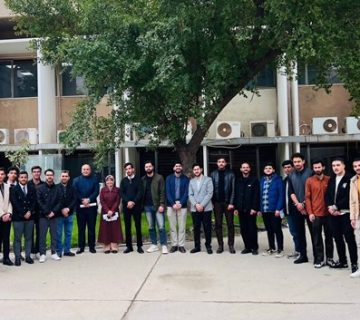The Chemical Engineering Department at the College of Engineering, University of Baghdad, held a M.Sc. thesis examination titled:
“ Combined Electrocoagulation-Electro-oxidation System for Reduction of Congo-Red Dye from Aqueous Solution ”
On Thursday, November 28, 2024. By the student “Reman Abbood Jasim” and supervised by Asst. Prof. Dr. Rash Habeeb Salman.
The examination committee consisted of Prof. Dr. Ammar S. Abbas as Chairman and the membership of Asst. Prof. Dr. Forat Yasir Sharrad and Asst. Prof. Dr. Tuqa Abdulrazzaq Flayh. The thesis was accepted after conducting a public discussion and listening to the student’s defense. The thesis was summarized as follows:
The aim of the study:
The present work aims to evaluate the performance of the combined EC-EO process to remove Congo red dye from an aqueous solution. This approach involves simultaneously depositing nano metal oxides onto a graphite substrate. The prepared nano oxide electrodes will be used as the anode for the electrooxidation (EO) process, while aluminum will serve as the sacrificial anode for the electrocoagulation (EC) process within the same electrolytic cell. A comparison will be made between the EC system, the EO system, and the combined EC-EO system to assess the differences in efficiency between the single and combined systems.
Abstract:
The current study introduces a combined electrochemical process of electrocoagulation (EC) and electro-oxidation (EO) to address the elimination of Congo red dye from synthetic wastewater. A triple composite of Co, Mn, and Ni nano oxides and Cu, Mn, and Ni nano oxides based on the graphite substrate by electrodeposition was conducted. Galvanostatic electrodeposition of Co-Mn-Ni oxides was accomplished with 0.075 M of each metal salt and an equivalent molar ratio (1:1:1), and Cu-Mn-Ni nano oxide with different concentrations of metal salts either with a mixing ratio 1:1:1, 2:1:1, 1:2:1, and 1:1:2. Electrodeposition was attended at constant current density 25 mA/cm2, within 3 hours. X-ray diffractometer (XRD), field emission scanning electron microscopy (FESEM), atomic force microscopy (AFM), and energy dispersive X-ray (EDX) characterized the structural and surface morphology of the multi-oxide sediment Co-Mn-Ni and Cu-Mn-Ni. As observed, the deposition process simultaneously took place on both the anode and cathode.
The efficiency of combining the EC and EO processes to break down 200 ppm of Congo red dye was investigated in a recent study. Three stainless steel electrodes were used as cathodes, aluminum was utilized as a sacrificial anode for the EC process, and composite (Co-Mn-Ni and Cu-Mn-Ni) based graphite electrodes were used as anode for the EO process.
Each prepared composite Co-Mn-Ni electrode (either anode or cathode) demonstrated symmetrical effectiveness as an anode for the EO process in the combined system. Three parameters (pH, current density, and NaCl concentration) were investigated, and the results were optimized by response surface methodology (RSM). The optimum operating conditions were a current density of 6 mA/cm2, pH = 7, and NaCl of 0.26 g/L. The results showed that the combined system eliminated more than 99.91% of the Congo red dye and chemical oxygen demand (COD) reduction of around 97% with 1.64 kWh/kg of dye of the consumed energy. The total operating cost for this experiment was 0.0937 US$/m3
The effectiveness of Composite Cu-Mn-Ni electrodes which were with different mixing ratios 1:1:1, 2:1:1, 1:2:1, and 1:1:2 were examined. The results showed that Cu-Mn-Ni composite cathodes were more effective in removing dye than their analogous anodes. 99% of the Congo red dye was reduced, and COD decreased by approximately 95%. It consumed 1.81 kWh/kg of energy with 0.105 US$/m3 as the total operating cost. These results were achieved using a composite cathode with a mixing ratio of 2:1:1, a current density of 6 mA/cm2 at pH =7, in the absence of NaCl salt, and within 20 minutes. The study compares the following systems: the combined system of EC-EO using a composite electrode (Cu-Mn-Ni) at a mixing ratio of 2:1:1; the EC process alone; the EO process alone with the same Cu-Mn-Ni composite electrode; and a combined system using a graphite electrode an anode for EO. The results for each system were 98%, 80%, 37%, and 84%, respectively. The combination of EC and EO effectively removed Congo Red dye without NaCl, preventing the hypochlorous acid formation and minimizing acidic byproducts. The combined EC-EO method is a promising, environmentally friendly approach for removing Congo Red (CR).








